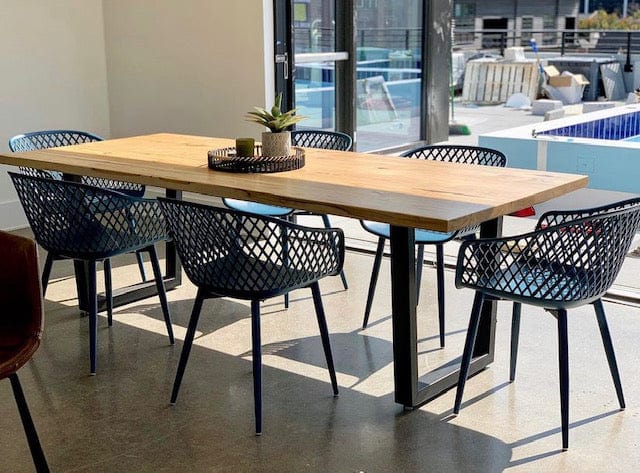Checking Out Different Designs for Dining Room Table Legs to Match Your Visual
An In-depth Appearance at Dining Table Leg Styles: Finding the Perfect Suit
Picking the ideal table leg style is critical for both visual charm and useful functionality. Traditional 4 legs provide timeless style and security, while the pedestal base provides raised legroom and a modern-day look. For those with larger tables, trestle legs guarantee sturdy assistance, whereas barrette legs present a mid-century modern-day ambiance with their minimal design. The x-shaped legs blend contemporary design with improved stability. Each of these options brings unique advantages, making the choice more than simply a matter of choice. Check out further to find which design flawlessly matches your dining area and lifestyle.
Traditional Four Legs
Among the numerous sorts of table leg styles, the conventional four-leg style continues to be an ageless option for several households. This classic configuration offers a harmonious mix of capability and aesthetic appeals, making it a seasonal fave. 4 legs supply balanced assistance, ensuring the table remains stable and capable of bearing substantial weight. This is particularly useful for homes that often host huge events or use their dining table for numerous purposes, such as work or crafting.
From an aesthetic viewpoint, the traditional four-leg layout can be conveniently adapted to various indoor designs. Whether crafted from wood, metal, or a mix of materials, these legs can be intricately sculpted, smooth and minimalistic, or anything in between. Their flexibility permits them to enhance both rustic and contemporary setups flawlessly.
Additionally, the simple framework of the four-leg style promotes simplicity of movement and positioning within a room. Unlike even more facility bases, this style minimizes blockages, offering ample legroom for restaurants. In summary, the traditional four-leg table leg style weds withstanding elegance with useful capability, making it a sharp choice for those looking for both type and feature in their dining furnishings.
Pedestal Base
Usually celebrated for its stylish and space-efficient design, the pedestal base is a notable option to the traditional four-leg configuration in dining table leg designs. Without corner legs, restaurants are paid for greater freedom of motion, making it a suitable selection for round and oval tables that promote more intimate and inclusive events.
The main column itself provides a canvas for elaborate designs and creative expressions, including an element of visual interest under the table. In summary, the pedestal base incorporates performance with design, making it an improved and functional option for varied dining environments.
Trestle Legs
Trestle legs supply a robust and ageless foundation for eating tables, characterized by their straight cross-bracing and durable check out here assistance beam of lights. Stemming from middle ages times, this design has evolved yet retained its necessary framework, making it a seasonal favorite in both traditional and contemporary setups. The central trestle light beam, More about the author often sustained by two or even more upright messages, supplies outstanding stability, allowing for larger table sizes without the need for extra legs.
A substantial advantage of trestle leg tables is the adequate legroom they provide. Unlike tables with 4 edge legs, the absence of obstructions at the table's sides provides unobstructed area for chairs and restaurants, enhancing comfort and access. This makes trestle tables perfect for fitting bigger events, whether in an eating room or a banquet hall.
The visual convenience of trestle legs is noteworthy. Offered in a range of materials such as wood, metal, and composite, they can be completed to enhance a vast range of interior designs. From rustic farmhouse to sleek modern styles, trestle legs can be personalized to match specific preferences. Their enduring allure and practical advantages make trestle legs an engaging selection for those looking for both design and usefulness in their dining table.
Barrette Legs

The appeal of hairpin legs hinges on their simplicity and versatility - dining room table legs. Offered in a series of materials, including steel and brass, they can be ended up in various shades to complement different indoor designs. Whether paired with a rustic wooden table top or a contemporary glass surface area, barrette legs easily blend performance with a touch of classic beauty
Sturdiness is another significant attribute of barrette legs. Despite their delicate appearance, these legs are engineered to birth considerable weight, making certain the dining table remains steady and safe. In addition, they are reasonably very easy to install, making them a prominent option for DIY lovers and expert furnishings manufacturers alike.
X-Shaped Legs

Constructed from materials such as steel, timber, or a mix of both, X-shaped legs can be customized to match various design preferences. Steel pop over to this web-site legs commonly lend a smooth and industrial feel, suitable for loft-style homes and modern dining spaces.
Furthermore, the design behind X-shaped legs makes sure also weight circulation, minimizing the risk of wobbling and enhancing longevity. This makes them especially appropriate for larger table that need extra support. Basically, X-shaped legs mix functional design with contemporary aesthetics, making them a timeless choice for varied eating settings.
Conclusion
A detailed understanding of eating table leg styles discloses the distinctive features and advantages of each layout. Standard four legs use security and ageless charm, while pedestal bases offer legroom and a streamlined look. Trestle legs guarantee robust assistance for larger tables, and hairpin legs introduce a mid-century modern-day visual. X-shaped legs integrate contemporary layout with boosted stability. Choosing the suitable leg design guarantees both useful and visual complete satisfaction in any eating space.